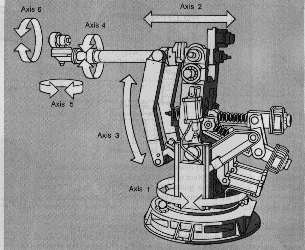|
|
|
![]()
![]()
The term industrial robot or robot is sometimes used in a routine way by laymen and experts. They sometimes use this term for a machine that performs a specific task in an automated way.
ISO, the International Standard Organization, have formulated the following definition with respect to robots and manipulators.
Robots for real-world factories can have large work envelopes, be branched, can carry large and heavy work pieces if they are Cartesian and are electro-mechanical.
Clever end effectors eliminate sensitivity to work tolerances and the need for close or indefinable positioning accuracy.
The workspace envelope of a robot is constrained by its mechanical systems configuration. Each joint of a robot has a limit of motion range. By combining all the limits, a constrained space can be defined. A workspace envelope of a robot is defined as all the points in the surrounding space that can be reached by the robot or the mounting point for the end effector or tool. The area reachable by the end effector itself is usually not considered part of a work envelope. Clear under standing of the workspace envelope of a robot to be used is important because all interaction with other machines, parts, and processes only takes place within this volume of space.
|
Since the
workspace envelope is defined by the joint motion range, given the robot
configuration and range limits, the workspace envelope can be derived. Robot
manufacturers usually provide drawings of workspace envelopes.
To design a robot application, the application workspace must be within the envelope. However, as discussed before, this envelope is defined by the end of the arm and does not consider what tool may be attached to the arm. Also, it only defines the position or points that can be reached. The possible orientations of the tool at each point have to be found separately. Since the tool orientation is affected not only by the base's three axes, but by the wrist joints and tool length, a kinematics equation including all these variables is needed. |
|
The work envelopes of the four most common configurations can be seen in the
figure on the right.
A degree of freedom can be defined as the direction in which a robot moves when a joint is actuated. Each joint usually represent one degree of freedom.
Most of the robots used today use five or six degrees of freedom. But this depends on the robot application, for example a pick-and-place application need only three axes specified when a welding robot requires five or six degrees of freedom. Six degrees of freedom are necessary to emulate the motion of a human arm and wrist.
The human upper arm, moving at the shoulder joint, has two degrees of freedom since it can rotate up and down and forward and backward in two angular directions. The lower arm, moving at the elbow joint provides the third degree of freedom. Wrist rotation is the fourth, wrist movement up and down is the fifth, and wrist movement left and right is the sixth. Operation of the thumb and fingers provides other degrees of freedom.
The robot degrees of freedom:The degrees of freedom of a robot depend upon its configuration. Lets consider an articulated-arm type, the six axes would then be: Arm and body motions:
Wrist motions:
|

|